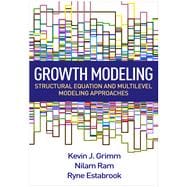User-Friendly Features
*Real, worked-through longitudinal data examples serving as illustrations in each chapter.
*Script boxes that provide code for fitting the models to example data and facilitate application to the reader's own data.
*"Important Considerations" sections offering caveats, warnings, and recommendations for the use of specific models.
*Companion website supplying datasets and syntax for the book's examples, along with additional code in SAS/R for linear mixed-effects modeling.
Winner--Barbara Byrne Book Award from the Society of Multivariate Experimental Psychology









